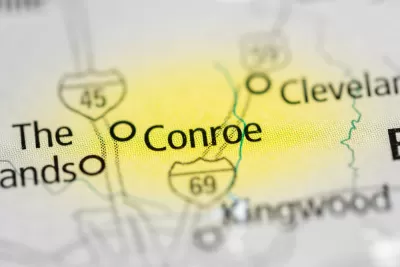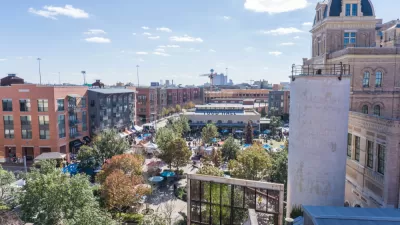The U.S. Census released its 2016 population data today. It feels a lot like a popularity contest.

The U.S. Census today announced new population estimates. On the Census Bureau website, the headlining news from the new report was that ten of the 15 fastest growing cities in 2016 are located in the South.
Conroe, Texas (near Houston), was the fastest-growing large city (population of 50,000 or more) between 2015 and 2016 at 7.8 percent, making its growth rate more than 11 times the nation’s growth rate of 0.7 percent. Some of the other fastest-growing cities were: Frisco, Texas (6.2 percent); McKinney, Texas (5.9 percent); Greenville, S.C. (5.8 percent); and Georgetown, Texas (5.5 percent).
A few more of the big takeaways from the report, as presented by the Census Bureau's announcement, include:
- Columbus, Ohio passing Indianapolis to become the 14th most populous city in the country.
- Regional differences in population change of small towns: 1) Northeast small towns declined by 0.5 percent, 2) Midwest small towns declined by 0.3 percent, 3) Small towns in the South grew by 0.2 percent, and 4) Western small towns saw the largest growth with an increase of 0.8 percent.
- League City, Texas was the only city to cross the 100,000 population mark in 2016. Five cities (Aliso Viejo, California; Parker, Colorado; Logan, Utah; Cerritos, Colorado; and Coeur d'Alene, Idaho) crossed the 50,000 mark.
Housing unit growth remains below pre-Recession levels in every state except North Dakota, Iowa, and the District of Columbia.
The Washington Post picked up the news, reporting on the national trends and focusing on the growth of suburban areas relative to cities. "In the tug of war between the suburbs and the city, the suburbs are once again on top, growing faster than cities for the first time since 2010," writes Tara Bahrampour in the lede of the article.
Mary Bowerman also reported on the country's fastest growing cities for USA Today.
Lyman Stone also wrote of how population estimates tend to be revised lower in cities where immigration is driving population growth. That tendency held true with today's release.
Finally, many local media outlets picked up the news of the new population estimates all over the country. Here is a sample of local stories:
- Seattle once again nation’s fastest-growing big city; population exceeds 700,000 (The Seattle Times)
- Frisco, McKinney in battle for nation's fastest-growing city, but a Texas rival edges them out (The Dallas Morning News)
- Census Bureau says Cleveland's population slips to 385,809; North Ridgeville fastest growing city regionally (Cleveland.com)
- Suburban growth remains strong in central Ohio (The Columbus Dispatch)
- It's official: Charleston is now South Carolina's largest city; Greenville among fastest-growing in nation (The Post and Courier)
- Detroit's population still down, despite hopes (Detroit Free Press)
- Nashville overtakes Memphis as Tennessee's largest city (The Commercial Appeal)
FULL STORY: The South Is Home to 10 of the 15 Fastest-Growing Large Cities

Trump Administration Could Effectively End Housing Voucher Program
Federal officials are eyeing major cuts to the Section 8 program that helps millions of low-income households pay rent.

Planetizen Federal Action Tracker
A weekly monitor of how Trump’s orders and actions are impacting planners and planning in America.

Ken Jennings Launches Transit Web Series
The Jeopardy champ wants you to ride public transit.

Tackling Soil Contamination With Nature-Based Solutions
Los Angeles County residents and experts are turning to nature-based methods like bioremediation to address long-standing and fire-exacerbated soil contamination without resorting to costly and disruptive removal.

Rebuilding Smarter: How LA County Is Guiding Fire-Ravaged Communities Toward Resilience
Los Angeles County is leading a coordinated effort to help fire-impacted communities rebuild with resilience by providing recovery resources, promoting fire-wise design, and aligning reconstruction with broader sustainability and climate goals.

When Borders Blur: Regional Collaboration in Action
As regional challenges outgrow city boundaries, “When Borders Blur” explores how cross-jurisdictional collaboration can drive smarter, more resilient urban planning, sharing real-world lessons from thriving partnerships across North America.
Urban Design for Planners 1: Software Tools
This six-course series explores essential urban design concepts using open source software and equips planners with the tools they need to participate fully in the urban design process.
Planning for Universal Design
Learn the tools for implementing Universal Design in planning regulations.
Ada County Highway District
Clanton & Associates, Inc.
Jessamine County Fiscal Court
Institute for Housing and Urban Development Studies (IHS)
City of Grandview
Harvard GSD Executive Education
Toledo-Lucas County Plan Commissions
Salt Lake City
NYU Wagner Graduate School of Public Service





























